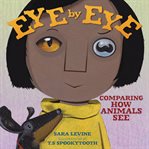Nonfiction
eAudiobook
Details
PUBLISHED
Made available through hoopla
EDITION
DESCRIPTION
1 online resource (1 audio file (9 min.)) : digital
ISBN/ISSN
LANGUAGE
NOTES
Read by TBD
An innovative look at animal eyes from the creators of Bone by Bone, Tooth by Tooth, and Fossil by Fossil. What kind of animal would you be if you had eight eyes? Or if your pupils were the shape of the letter W? Keep an eye out for weird and surprising facts in this playful picture book, which brings together comparative anatomy with a guessing game format. See how your animal eyes are like-and unlike-those of starfish, spiders, goats, cuttlefish, owls, and slugs. Author Sara Levine and illustrator T.S Spookytooth present an insightful view of all eyes can do! "The brilliant pairing of author, educator, and veterinarian Levine and artist with a funny bone Spookytooth yields a mix of fun, facts, and conjecture. A fabulous addition to classroom studies of animals and nonfiction literature. Also perfect for personal enjoyment."-starred, School Library Journal "An appealing offering of 'what if?' questions, laugh-out-loud illustrations, and clearly presented information details how different animals see. The book begins by posing questions ('Have you ever wondered what it would be like to see the world through someone else's eyes?' 'What if those eyes belonged to an animal?') and providing context for comparing animal eyes ('Most animals have eyes, but not all eyes are the same.'). The text offers surprising, informative answers. The question, 'What kind of animal would you be if you had eight eyes?' is accompanied by an illustration of a tan-skinned child with eight eyes. When readers turn the page, they learn that the answer is 'a spider!' and that some spiders can have as many as 12 eyes. Brown-skinned children, including a girl wearing hijab, are pictured throughout. Levine describes the eyes of sea stars, snails, slugs, flounders, and owls and how the pupils of different animals (such as goats, cats, and cuttlefish) differ in terms of their shape. She also explains that not all eyeballs are smooth and that some animals see colors differently than humans do. The book ends with thought-provoking activities. VERDICT The brilliant pairing of author, educator, and veterinarian Levine and artist with a funny bone Spookytooth yields a mix of fun, facts, and conjecture. A fabulous addition to classroom studies of animals and nonfiction literature. Also perfect for personal enjoyment."-starred, School Library Journal "This picture book asks readers to imagine having the eyes of various different animals. What kind of animal would you be if you had eight eyes? Turn the page to find out: a jumping spider. What if you had six eyes, each at the end of an arm instead of a hand? What if you had rectangular pupils? Brown-skinned children, one wearing hijab, are pictured modeling the imagined eye structures, interacting with animals and insects, and learning from books and charts. The pattern of asking a question and answering it on the next page works to keep readers engaged, guessing and turning pages. The pictures of children with extra eyes, moving eyes, antennae, and animalistic pupils are intriguingly bizarre to look at and will likely keep curious children coming back to this book for stares and giggles. The text is fairly lengthy for a picture book and offers profound scientific information; though it is easy to understand, the spidery, thin cursivelike type that conveys it is a little daunting for youngsters. Unanswered questions are included in the text, showing that science is an ongoing investigation. The backmatter includes simple activities, more about pupils, a glossary, and further reading. (This book was reviewed digitally with 11-by-18.5-inch double-page spreads viewed at 29.5% of actual size.) A fascinating and (mostly) well-formatted exploration."-Kirkus Reviews
Mode of access: World Wide Web







